Archived Fire Damage Blog Posts
National Burn Awareness Week with SERVPRO® Team Spinner and the American Burn Association
2/9/2024 (Permalink)
 Always be mindful of how to handle flammable liquids!
Always be mindful of how to handle flammable liquids!
At SERVPRO® Team Spinner, we're committed to not only restoring properties but also promoting safety and well-being within our communities. With National Burn Awareness Week here, it's crucial to shed light on the importance of burn prevention and safety measures. Burns are not only painful injuries but can also lead to long-term physical and emotional trauma.
In this blog post, we'll explore the significance of National Burn Awareness Week and how SERVPRO Team Spinner is dedicated to spreading awareness and fostering a safer environment for all.
National Burn Awareness Week is hosted by the American Burn Association. This year's ABA theme is flammable liquids.
According to the National Fire Protection Association, Flammable and/or combustible liquids cause more than 51,000 home fire each year, resulting in 168 deaths, 1,029 injuries, and $644 million in property damage.
How do you handle flammable liquids? Handle with Care, Flammable Liquids Beware.
- Gasoline is an extremely flammable liquid and vapor with fumes capable of ignition up to 12 ft from a pooled source.
- All flammable liquid containers should be kept in cool, dry locations, and stored away from the home.
- Cooking oil is a highly flammable liquid. Keep your eyes on what you fry!
- Grills and gas ranges produce a lot of heat; keep your cooking area clear when around an open flame.
- Fuel lawnmowers, leaf blowers, and weed eaters when the engines are cool and in open area outdoors.
- Fuel snow blowers when the engines are cool and in an open area outdoors.
- Never use an accelerant such as gasoline, kerosene, or aerosol sprays to start a camp fire.
- When purchasing a gas can, be sure it has a fuel arrestor on the can to prevent flashback.
Stay tuned for additional valuable information and actionable steps to ensure safety in your homes, workplaces, and communities.
Together, we can make a difference.
Lunar New Year Firework Caution: Ensuring a Safe Celebration
2/9/2024 (Permalink)
 It's the Year of the Dragon!
It's the Year of the Dragon!
Lunar New Year, also known as Chinese New Year or Spring Festival, is a time of vibrant festivities marked by colorful parades, delicious feasts, and joyous celebrations. Fireworks are an integral part of many Lunar New Year traditions, symbolizing the ushering in of good luck and prosperity. While fireworks add to the excitement of the occasion, it's essential to prioritize safety to prevent accidents and ensure a memorable celebration. In this blog post, we'll explore important Lunar New Year firework precautions with insights from SERVPRO® Team Spinner, a trusted leader in restoration and cleanup services.
Check Local Regulations: Before purchasing or using fireworks, familiarize yourself with local regulations and restrictions. Laws regarding fireworks vary from one area to another, and it's crucial to adhere to them to avoid fines or legal consequences. SERVPRO Team Spinner advises checking with your local authorities to ensure compliance with safety guidelines.
Choose a Safe Location: Select a suitable location for setting off fireworks, away from buildings, dry vegetation, and other flammable materials. SERVPRO Team Spinner recommends using open, spacious areas such as parks or designated firework zones. Avoid firing fireworks in crowded or confined spaces to prevent accidents and injuries.
Keep Water Sources Handy: Have water sources such as buckets, hoses, or fire extinguishers readily available in case of emergencies. SERVPRO Team Spinner emphasizes the importance of being prepared to extinguish small fires or accidents quickly to prevent them from escalating.
Designate a Responsible Operator: Assign a responsible adult to handle and ignite the fireworks. This individual should be sober, knowledgeable about firework safety procedures, and capable of managing potential risks. SERVPRO Team Spinner suggests ensuring that children and bystanders maintain a safe distance from the fireworks at all times.
Follow Instructions Carefully: Read and follow the manufacturer's instructions and safety guidelines provided with the fireworks. Use fireworks only as intended and avoid modifying or tampering with them in any way. SERVPRO Team Spinner advises against attempting to relight malfunctioning fireworks and recommends disposing of them safely.
Protective Gear: Wear appropriate protective gear such as safety glasses and gloves when handling fireworks. SERVPRO Team Spinner emphasizes the importance of protecting your eyes, hands, and skin from potential sparks or debris during the firework display.
Dispose of Debris Properly: After the fireworks have been used, carefully collect and dispose of any debris or spent fireworks. SERVPRO Team Spinner recommends soaking them in water before placing them in a designated trash container to prevent accidental fires.
As you celebrate Lunar New Year with fireworks and festivities, remember to prioritize safety for yourself, your loved ones, and your community. By following these firework precautions from SERVPRO Team Spinner, you can ensure a joyful and accident-free celebration. May the Year of the Dragon be filled with prosperity, happiness, and peace. Happy Lunar New Year!
Celebrate Safely: Firework Safety Tips for a Happy New Year
1/2/2024 (Permalink)
 The New Year celebrations aren't over yet!
The New Year celebrations aren't over yet!
As we usher in the New Year with joy and excitement, it's essential to prioritize safety, especially when it comes to celebrating with fireworks at home. While fireworks add a dazzling touch to the festivities, mishandling them can lead to accidents and property damage. At SERVPRO® Team Spinner, we want you to have a memorable and safe New Year's celebration. In this blog post, we'll share essential firework safety tips to ensure your festivities are filled with joy and not unexpected emergencies.
Understanding the Risks:
Fireworks can pose significant risks when not handled with care. Common dangers include burns, injuries, and the potential for fires. Understanding these risks is the first step toward a safer celebration.
Legal and Safety Compliance:
Before planning a fireworks display, familiarize yourself with local laws and regulations regarding the use of fireworks. Ensure that the fireworks you choose comply with safety standards and are legally permissible in your area.
Selecting a Safe Location:
Open Space: Opt for a spacious, open area away from buildings, dry grass, and other flammable materials.
Avoid Crowded Areas: Steer clear of crowded places, and maintain a safe distance from spectators to prevent injuries.
Preparation and Planning:
Fire Extinguishers: Have a fire extinguisher and a bucket of water nearby as a precautionary measure.
Professional Displays: If possible, consider attending professional firework displays instead of setting off fireworks at home. These displays are conducted by trained experts in controlled environments.
Safe Handling Practices:
Adult Supervision: Never allow children to handle fireworks. Ensure that responsible adults are supervising the entire process.
Read Instructions: Carefully read and follow the instructions on each firework. Different fireworks have varying safety guidelines.
One at a Time: Ignite one firework at a time, and move away quickly after lighting.
No Alcohol: Avoid consuming alcohol while handling fireworks. Clear judgment is crucial for safety.
Post-Display Safety:
Dispose of Properly: Dispose of used fireworks by soaking them in water before placing them in a trash bin.
Check for Strays: After the display, check for any unexploded fireworks and properly dispose of them to prevent accidental ignition.
A safe and happy New Year's celebration is within reach with responsible firework practices. At SERVPRO Team Spinner, we wish you a joyous start to the New Year. By prioritizing safety, you can create lasting memories without compromising the well-being of yourself, your loved ones, or your property. Here's to a wonderful and safe New Year!
Kwanzaa Candle Lighting Caution: A SERVPRO® Guide to Safety
12/28/2023 (Permalink)
 Happy Kwanzaa from SERVPRO Team Spinner
Happy Kwanzaa from SERVPRO Team Spinner
Kwanzaa, a celebration of African heritage and culture, is marked by various rituals, one of which is the lighting of the Kinara. This symbolic candle holder represents the seven principles of Kwanzaa, known as the Nguzo Saba. While the lighting of the candles is a beautiful and significant part of the festivities, safety should always be a top priority. In this blog post, we'll explore essential Kwanzaa candle lighting precautions with insights from SERVPRO Team Spinner, a leading restoration and cleanup service.
Secure Placement: When placing the Kinara, ensure it is on a stable, non-flammable surface. SERVPRO Team Spinner recommends placing it away from curtains, tablecloths, or any other combustible materials. A secure placement minimizes the risk of accidental fires and enhances the safety of your Kwanzaa celebration.
Supervision and Responsibility: Never leave a lit Kinara unattended. Whether using traditional candles or modern electric lights, maintaining supervision ensures a swift response to any unforeseen incidents. SERVPRO Team Spinner emphasizes the importance of responsible candle management to prevent potential fire damage during the Kwanzaa celebration.
Keep a Clear Radius: Create a clear radius around the Kinara to prevent any accidental knockovers. Especially in households with children or pets, a little extra caution can go a long way in avoiding accidents. SERVPRO Team Spinner recommends securing the Kinara in place to minimize the risk of it being accidentally bumped or tipped.
Candle Selection: Choose candles that fit securely in the Kinara's candle holders. Loose or improperly sized candles can tilt, increasing the risk of fire. SERVPRO Team Spinner suggests using high-quality, dripless candles to reduce mess and minimize the likelihood of a fire spreading.
Keep Flammable Items Away: During the candle lighting ceremony, remove any flammable materials from the immediate vicinity of the Kinara. SERVPRO Team Spinner advises against placing paper, napkins, or any easily combustible items near the candles to avoid accidental ignition.
Emergency Preparedness: Accidents can happen even with the utmost caution. SERVPRO Team Spinner suggests having a fire extinguisher nearby and ensuring that everyone in the household is familiar with its operation. Knowing emergency exit routes and having a plan in place to evacuate the premises safely is also crucial.
Regular Maintenance: Before each use, inspect the Kinara for any signs of wear or damage. SERVPRO Team Spinner recommends cleaning the candle holders regularly to remove any wax buildup, reducing the risk of flare-ups during candle lighting.
As you celebrate Kwanzaa with family and friends, remember that safety should always be a top priority. By following these Kwanzaa candle lighting precautions from SERVPRO Team Spinner, you can ensure a festive and secure holiday season. May your Kwanzaa be filled with unity, creativity, and the glow of safely lit candles.
Safety First: Why Frying Turkey Can Pose Thanksgiving Hazards
11/15/2023 (Permalink)
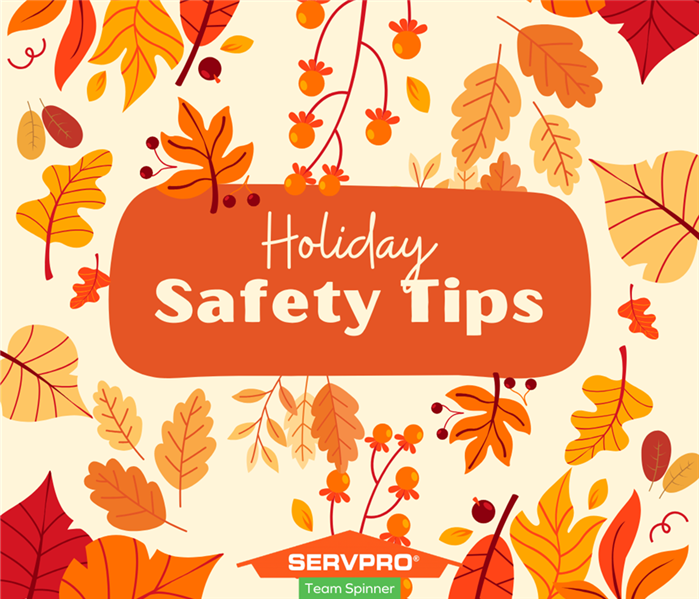 Holiday Safety Tips from SERVPRO Team Spinner
Holiday Safety Tips from SERVPRO Team Spinner
Thanksgiving is a time for family, gratitude, and of course, delicious food. While many embrace the tradition of roasting a turkey in the oven, the trend of deep-frying turkeys has gained popularity in recent years. At SERVPRO Team Spinner, our commitment to community safety prompts us to shed light on the potential hazards associated with deep-frying turkeys and to encourage a Thanksgiving celebration that prioritizes safety.
Risks of Deep-Frying Turkey:
Fire Hazard: Deep-frying a turkey involves immersing it in hot oil, creating a potential fire hazard. The oil can overheat, leading to a dangerous situation. According to the National Fire Protection Association (NFPA), turkey fryers are responsible for numerous fires each year, causing significant damage to homes and properties.
Hot Oil Burns: Handling hot oil poses a serious risk of burns and injuries. The process of lowering a turkey into boiling oil requires caution and precision. Accidents can happen when individuals are not familiar with the proper safety measures or when equipment is not used correctly.
Lack of Experience: Deep-frying a turkey requires a certain level of expertise and experience. Individuals attempting it for the first time may underestimate the potential dangers involved, leading to accidents that could have been avoided with proper knowledge and preparation.
SERVPRO Team Spinner's Safety Tips:
Choose Safety Over Speed: While deep-frying may offer a quicker cooking time, it's essential to prioritize safety. Consider alternative cooking methods that eliminate the risk of hot oil and open flames.
Maintain a Safe Distance: If you choose to fry your turkey, ensure the fryer is set up a safe distance from structures, including your home. An outdoor, flat, and stable surface is crucial to prevent accidents.
Thaw the Turkey Completely: Thoroughly thaw the turkey before frying to prevent oil splatters and reduce the risk of fire. Ice or water on an unfrozen turkey can cause the hot oil to bubble and splatter.
Never Leave Unattended: Supervise the turkey fryer at all times. Leaving it unattended increases the risk of accidents and potential disasters.
At SERVPRO Team Spinner, we prioritize the safety and well-being of our community. As you prepare for Thanksgiving, consider the potential risks associated with deep-frying a turkey. Opt for safer cooking methods to ensure a joyous and incident-free holiday celebration. Let's make this Thanksgiving a time of gratitude and happiness, without compromising the safety of our loved ones and homes.
Shine Bright, Stay Safe: Diwali Fire Caution from SERVPRO Team Spinner
11/14/2023 (Permalink)
 Happy Diwali from SERVPRO Team Spinner!
Happy Diwali from SERVPRO Team Spinner!
Diwali, a joyous festival of lights, was on Monday, November 13. Unfortunately, during this festive holiday, a fire is not an uncommon occurrence.
The team at SERVPRO wants to share some important fire safety precautions to ensure your celebrations remain bright and safe for next year or for anyone celebrating later this week.
Diwali is a time for family, friends, and beautiful decorations, but it's crucial to be mindful of potential fire hazards. Here are some tips to keep your Diwali festivities safe and enjoyable:
Inspect Electrical Decorations: Before decking out your home with colorful lights and electronic decorations, carefully inspect each item for frayed wires, damaged sockets, or any signs of wear. Replace any damaged items to prevent electrical fires.
Avoid Overloading Outlets: Distribute your electrical load evenly and avoid overloading outlets. Plugging too many devices into a single outlet can lead to overheating and increase the risk of a fire.
Use LED Lights: Opt for LED lights over traditional incandescent ones. LED lights produce less heat, reducing the risk of fire. Additionally, they are more energy-efficient and have a longer lifespan.
Keep Flames in Check: If you include traditional diyas or candles in your celebrations, ensure they are placed in stable holders and are kept away from flammable materials. Never leave lit candles unattended.
Maintain Safe Distances: Keep decorations, including curtains, drapes, and other combustible items, away from heat sources and open flames. Maintain a safe distance to prevent accidental fires.
Supervise Fireworks Displays: If fireworks are a part of your Diwali tradition, exercise caution and follow local safety guidelines. Ensure that fireworks are lit in open areas, away from buildings and dry vegetation.
Keep Fire Safety Equipment Handy: Have fire extinguishers and smoke detectors in strategic locations within your home. Regularly check and maintain these devices to ensure they are in good working condition.
Create an Emergency Plan: In the event of a fire, have a well-thought-out emergency plan in place. Ensure that all family members are aware of the evacuation routes and meeting points.
Dispose of Ashes Safely: If you use fire pits or burn incense during Diwali, ensure that ashes are fully extinguished before disposal. Dispose of ashes in a metal container, away from combustible materials.
Stay Informed: Keep yourself informed about local fire safety regulations and guidelines. Understanding and following these regulations is crucial to ensuring a safe and enjoyable Diwali.
At SERVPRO Team Spinner, your safety is our priority. We wish you a Happy and Safe Diwali filled with light, laughter, and moments of joy. Shine on, and let's celebrate responsibly!
Protecting Your Home: Fall Fire Safety and Holiday Season Fire Prevention
10/4/2023 (Permalink)
As the leaves change colors and the air turns crisp, autumn ushers in a season of warmth, family gatherings, and festive celebrations. However, it's also a time when fire risks can increase, and it's crucial to keep your home and loved ones safe. At SERVPRO® of Hamilton & South Trenton, we are dedicated to promoting fire safety year-round. In this blog post, we'll discuss essential tips for autumn fire safety and how to prevent fire incidents during the holiday season.
Fall Fire Safety:
1. Heating Safety:
With temperatures dropping, many homeowners rely on heating systems to keep warm. Ensure your heating equipment, whether it's a furnace, fireplace, or space heater, is in good working condition. Have them inspected and cleaned regularly to prevent potential fire hazards.
2. Chimney Maintenance:
If you have a wood-burning fireplace, autumn is an ideal time for chimney maintenance. Clear any debris or nests from your chimney, and check for creosote buildup, a highly flammable substance that can ignite and lead to a chimney fire.
3. Smoke Alarms and Carbon Monoxide Detectors:
Test your smoke alarms and carbon monoxide detectors to make sure they're functioning correctly. Replace batteries if needed, and consider installing interconnected alarms to provide early warning in case of a fire.
4. Dryer Vent Cleaning:
Dryer vents can accumulate lint over time, increasing the risk of a fire. Regularly clean your dryer vent and check for any blockages.
Holiday Season Fire Prevention:
1. Safe Decorating:
During the holiday season, homes are adorned with festive decorations. Be cautious with candles, string lights, and other decorations near flammable materials. Never leave candles unattended, and use flameless candles as a safer alternative.
2. Cooking Safety:
Holiday feasts are a tradition for many families. Stay attentive when cooking, and keep flammable items, such as dish towels and oven mitts, away from the stovetop. Use a timer to remind you when dishes are ready to avoid distractions.
3. Christmas Tree Safety:
If you have a live Christmas tree, keep it well-watered to prevent it from becoming a fire hazard. Ensure that string lights are in good condition and do not overload electrical outlets.
4. Fire Escape Plan:
Discuss and practice a fire escape plan with your family. Make sure everyone knows how to exit the house safely in case of an emergency. Designate a meeting point outside the home.
SERVPRO® of Hamilton & South Trenton is committed to helping you keep your home safe during the autumn season and throughout the holidays. By following these fire safety tips, you can enjoy the beauty and warmth of the season without worrying about potential fire risks. Remember that prevention is key, but in the event of a fire emergency, our team is here to help restore your home to its pre-fire condition. Stay safe and have a joyful autumn and holiday season!
Have Questions about Fire, Smoke, or Soot Damage?
Call Us Today – (908) 650-8611
Can You Identify Common Fire Hazards in Your Home?
10/3/2022 (Permalink)
 House fires can be lethal. Know the common fire hazards in your home to stay safe.
House fires can be lethal. Know the common fire hazards in your home to stay safe.
Nobody wants to think about the possibility of their home being damaged by fire, but it’s an unfortunate, harsh reality for a multitude of Americans.
One way you can help protect your home is to understand fire hazards and know how to identify them. In this blog, let’s dive into two of the most common causes of household fires.
Candles are a common fire hazard.
According to the National Fire Protection Association, over a five-year period from 2011 to 2015, fire departments across the United States answered an estimated 8,700 house fires a year that were caused by candles.
In total, these fires caused 82 deaths, 800 injuries and $295 million in property damage. Candles were the cause of 2 percent of reported house fires, of which 3 percent resulted in death and 7 percent resulted in injuries.
An average of 24 home candle fires per day were reported during those five years, with December having the highest month of incidents. Out of all the candle fires during this time period, 37 percent started in the bedroom and were responsible for 36 percent of the associated deaths and 51 percent were associated with injuries.
When using a candle, be sure it’s kept at least one foot away from anything that could possibly ignite and that it is in a sturdy holder that will not easily tip over. It is never wise to use a candle where oxygen is in use in a home. And you always want to ensure that all candles are properly extinguished before leaving a room or going to sleep.
House fires from smoking can be lethal.
While cooking is the leading cause of house fires, smoking is the main cause of home fire deaths. Approximately 17,200 house fires were reported in 2014 due to smoking, which includes cigarettes, pipes and cigars. Those fires resulted in 570 deaths, 1,140 injuries and $426 million in property damage, according to the Coalition for Fire-Safe Cigarettes.
If you’re a smoker, it is smart to smoke outside, as most deaths result from fires that started in living rooms, family rooms or bedrooms. Fire-safe cigarettes are the best option, and using a deep, sturdy ashtray is advised.
Drop all lit cigarettes and ashes in water or sand prior to throwing them out—and remember that one out of four fatal victims of smoking fires is not the smoker whose cigarette started the fire.
Dust bunnies as fire hazards?
While candles and smoking are well-known causes of home structure fires, were you aware that some glassware in your home could be a fire risk? When sunlight passes through them, the concentrated ray may ignite flammable materials. It’s best to keep glass accessories away from windows and out of direct sunlight.
Dust bunnies can also pose a fire risk when they collect near electrical sockets and floor heaters. Regular sweeping or vacuuming regularly and cleaning hard-to-reach areas like behind entertainment systems can help prevent buildup.
Also, look for loose outlets in your home. The movement of these outlets loosens the wires connected to the outlet and could create dangerous arcing.
Statistics on Main Causes of Fires
8/1/2022 (Permalink)
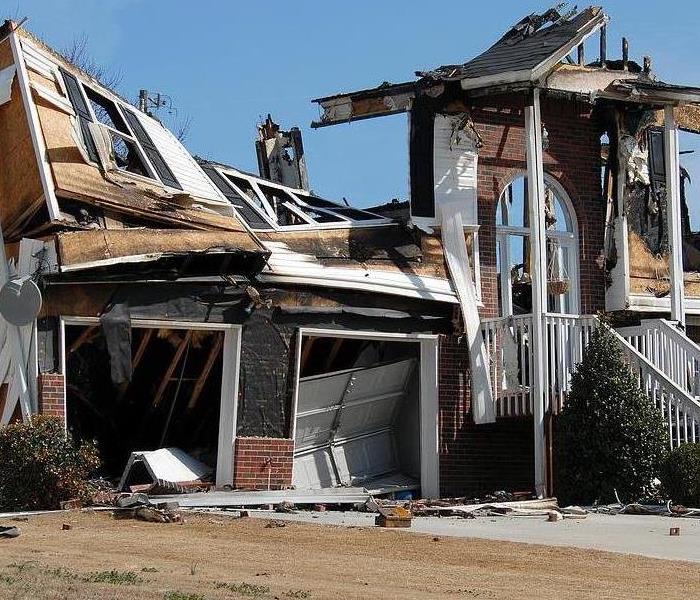 If you experience fire damage, call us and we will help make "Like it never even happened."
If you experience fire damage, call us and we will help make "Like it never even happened."
Unfortunately we all know for a fact that fires happen. As much precaution as we take to prevent them, they happen! So then what are the main causes of fires starting? The U.S. Fire Administration estimated that the leading reported causes of fires in non-residential buildings for 2013 was due to cooking materials (29.3%), intentional (9.7%), and carelessness (9.2%). However, The National Fire Protection Association (NFPA) broke down the statistics on the main causes of fire in healthcare, educational, and commercial properties.
Healthcare
In the healthcare arena, the U.S. fire departments responded to an estimated average of 6,240 structure fires during 2006-2010.
61% of fires were due to cooking equipment
7% of fires were due to clothing equipment
6% of fires were started intentionally
While cooking equipment seemed to have been the leading cause of fires, nursing homes were more likely to have fires involving clothes washer & dryer. And facilities providing care of those with developmental disabilities, mental illness or substance abuse had more fires that were intentionally set.
Education
In the educational arena, during 2007-2011 an estimated average of 4,060 structure fires per year were reported in educational facilities. And an estimated 700 structure fires per year were reported in college classrooms and adult education centers.
13% of fires began in a kitchen or cooking area
49% of fires were started intentionally
32% occurred in the lavatory or bathroom
Most fires in educational properties occurred in nursery, elementary, middle, or high schools.
Commercial
In the commercial arena, an estimated average of 3,700 fires in hotels were reported to the U.S. fire departments during 2006-2010. And the U.S. fire departments responded to an estimated average of 3,340 fires in offices during 2007-2011.
In Hotels:
45% of fires were due to cooking equipment
10% of fires were due to smoking material
9% of fires were due to heating equipment
Nearly three-quarters of fires in hotels didn’t spread beyond their origin. However, fires that began in a bedroom were responsible for 31% of civilian injuries and 72% of civilian deaths. Smoking materials were the cause of the fire in 79% of civilian deaths.
In Office Buildings:
29% of fires were due to cooking equipment
12% of fires were due to electrical and wiring equipment
11% of fires were due to heating equipment
Although cooking equipment was the leading cause of office fires, it only accounted for just 6% of the direct property damage. Electrical and lighting equipment caused 15% of direct property damage, while fires that were intentionally set caused 20% of direct property damage.
All in all cooking and electrical equipment, carelessness as well as fires set intentionally, are the main causes of fire. So what can you do to prevent fires from happening? Be cautious when using electricity or any kind of heating equipment and make sure your passive fire protection system (fire/smoke dampers, fire doors, and firestop) are inspected and tested to help ensure that your building as well as its occupants are safe in case of a fire.
If you experience a fire, call us at 609-256-8890 and we will make it like it never even happened!
Business Safety
8/1/2022 (Permalink)
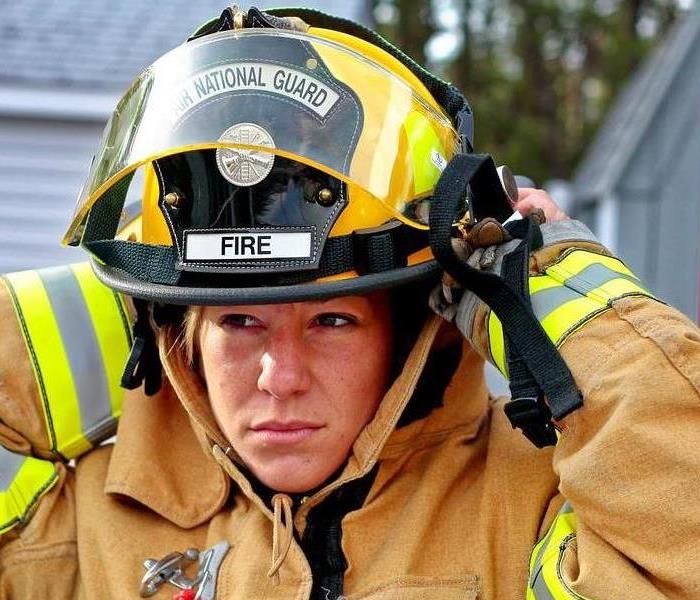 Follow these tips to keep your business safe in case of a fire.
Follow these tips to keep your business safe in case of a fire.
Fire Safety Tips for the Workplace
No matter what type of business you conduct at your workplace, fire safety should always be a main concern. Here are a few fire safety tips you can distribute to your staff:
Fire Prevention
- Keep your work area free of waste paper, trash and other items that can easily catch fire.
- Check on your electrical cords. If a cord is damaged in any way, replace it. Try not to lay cords in places where they can be stepped on, as this will contribute to deterioration of the protective outside coating.
- Don't overload your circuits.
- Turn off electrical appliances at the end of each day.
- Keep heat producing equipment away from anything that might burn. This includes copiers, coffee makers, computers, etc.
In the Event of a Fire
- Upon finding a fire, call 911 immediately and don't hand up with the emergency responder until told to do so.
- Close doors when exiting to help limit the spread of smoke and fire throughout the building.
- Never use elevators during an evacuation.
- Follow the escape plan and meet at a per-determined place outside of your building and away from danger. Conduct a headcount to ensure all of your staff has evacuated.
The best way to ensure the safety of your staff is through fire prevention and preparation. Talk with your staff about fire safety in the workplace today.
Fires in Kitchens
8/1/2022 (Permalink)
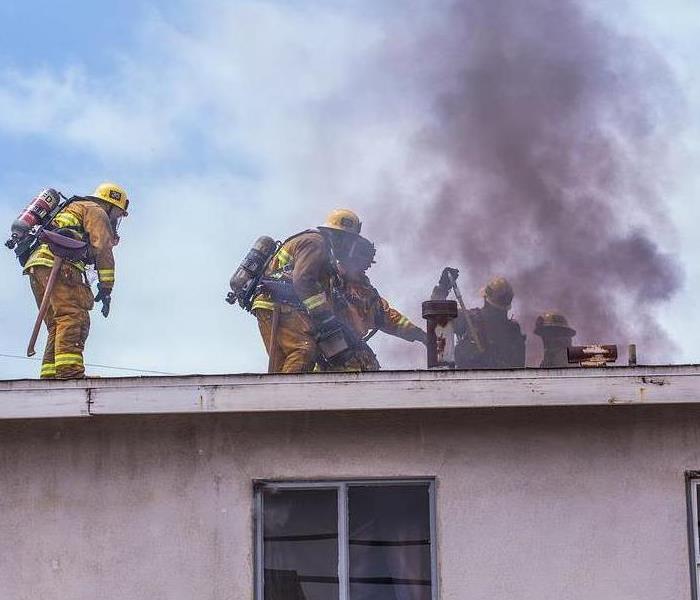 Follow these tips to stay safe from kitchen fires.
Follow these tips to stay safe from kitchen fires.
Cooking fires are the number one cause of home fires and home fire injuries. Home fires are more likely to start in the kitchen than any other room in your home. Unattended cooking causes nearly 90 percent of all kitchen fires. Here are some tips to prevent Kitchen fires.
- Never leave cooking food unattended! Fires can happen spontaneously. Cooking food should always be monitored. Make sure if you leave the room, to turn off the stove.
- Avoid any loose clothing. Baggy t-shirts or dangling sleeves can potentially catch on fire while around a stove.
- Always watch your kids! For parents, we want to keep our kids safe and sound from any fires. Try to avoid having your child(ren) around cooking areas. At least 3 feet away from the stove is ideal to insure their safety.
- Try to keep anything that can catch on fire away from your stove stop. This can include oven mitts, wooden utensils, paper or plastic bags, and towels or curtains. Materials like such can generate heat.
- Consider purchasing a fire extinguisher to keep in hands reach in your kitchen.
The Public Adjuster
7/18/2022 (Permalink)
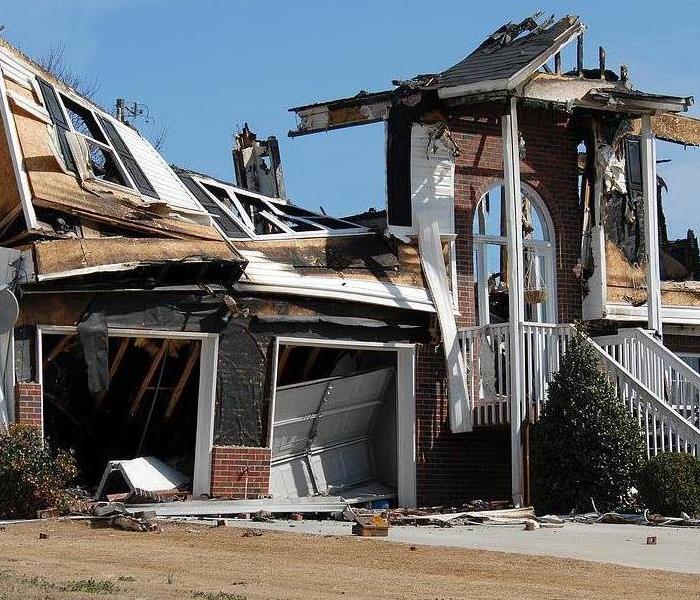 Fires can destroy homes, know your options of how to get help.
Fires can destroy homes, know your options of how to get help.
If you have ever filed an insurance claim, whether it be for your home, auto or health, you know it can be a very stressful process fraught with uncertainty and questions. Will I be covered? How much will I be covered for? How will it impact my premiums?
Because of this confusion and uncertainty, many turn towards a Public Adjuster to get them through their ordeal. But, before engaging a Public Adjuster, there are a few things you need to be aware of.
What happens first?
After you’ve taken care of your loved ones, you will need to get your home back in order. When you have a damaging event to your home, for which you wish to submit a claim, one of the first things you should do is to contact your agent or your insurance company directly.
Your insurance company will record your loss and issue you a claim number. They will also assign an internal or independent adjuster to review your claim. This adjuster works on behalf of the insurance company. This adjuster will schedule a visit to your home to inspect and assess the loss to determine coverage. This is a benefit to you as a policyholder and does not cost you anything.
Once coverage is determined, the insurance company’s adjuster will then discuss actions that need to be taken immediately, such as getting the home dried out or possibly boarded up if needed. They’ll then provide you with their assessed value of the loss.
So now comes the question of whether or not to use a Public Adjuster. Let’s go through this.
Exactly what is a public adjuster?
A public adjuster is someone that you pay to help you with your insurance claim. They are an insurance claims specialist who interprets the homeowner's policy, assesses the damage and how much it will cost to repair, and negotiate with the insurance company on behalf of the homeowner until the claim is settled.
The Public Adjuster does not represent your insurance company nor is he/she assigned by your insurance company. Public Adjusters are sought and hired by you to be your representative and deal with your insurance company. For their services, they will charge you a fee, typically a percentage of the total award amount that they negotiate with your insurance company.
Remember, a Public Adjuster can assist with the claims process, but cannot get you more money than you are entitled to under your insurance policy and will not be able to get your claim settled any faster. You are simply paying them for a service.
OK, so when should I use a Public Adjuster?
Many will hire a Public Adjuster simply because they don’t have the time to deal with the claim. Remember, though, you are paying a fee for this convenience.
Typically, the Public Adjuster will charge a fee of 10%-15% of the final claim awarded. This can be a sizable fee, so be sure before you sign any paperwork. It’s also important to know that this fee can be negotiated depending on the size of the loss.
If you chose to deal with the claim personally, there are steps you can take before bringing a Public Adjuster in. Your insurance company is a reputable business and they want you to continue to be a policyholder.
If you feel you can justify additional damages, speak with your insurance company’s assigned adjuster and present your case. If you are not getting anywhere, ask to speak with a more senior representative. You may find that these steps yield good results.
If you still feel that you need more representation, this is when you may consider working with a Public Adjuster. It’s really a judgment call as to whether or not you believe your loss, and the associated damages you claim, are fairly reflected in your insurance company’s assessment.
Before you proceed, do some simple math.
Let’s say you had a fire loss, for which your insurance company has assessed a $200,000 payment to cover the loss, but you feel you are entitled to $20,000 more and you have not been successful with your discussions with your adjuster. So, you hire a Public Adjuster with a fee of 10%. At the end of it, he argues and wins $10,000 more from your insurance company for a total payment of $210,000. The fee will be $21,000 to the Public Adjuster, netting you $189,000. You would have been better off accepting the initial payment offered by the insurance company.
How can I find a good Public Adjuster?
As with anything else, a Public Adjuster can be found by doing some internet searches. Another place to start would be going to the NAPIA website. They have a vetting process and require their members to be licensed and to have been in business for at least 2 years.
Some steps you should think about:
- Always avoid any Public Adjuster who tries to pressure you into signing a contract. Remember this is a business transaction.
- Interview several.
- Get reference lists and check with their prior clients.
- Check their company websites.
- You can also ask friends and colleagues who they might recommend.
- Avoid single practitioners or small firms unless they demonstrate a good track record.
Before signing anything, make sure your rights are protected:
- Determine how long you have to cancel any contract you sign. New Jersey protects consumers with a 72-hour cancellation provision under the Consumer Fraud Act.
- Verify that the Public Adjuster will remove any lien once the contract is terminated.
- Limit the contract to no more than six months.
Once you’ve identified your Public Adjuster, you will sign a contract between you and them, which obligates your relationship with them until the claim is settled. The Public Adjuster will likely place a lien on your insurance claim, naming them as an additional payee on all payments from your insurance company.
What role with the Public Adjuster play in the process?
So now you’ve hired a Public Adjuster. Here’s what you can count on him doing and what you should not expect.
You will still be very involved in helping the Public Adjuster document the loss. He will need details of the event and information about content damage and their value.
A public adjuster will assess your losses and help you get every penny you deserve, but don't expect miracles. Understand the insurance company may not agree to everything you want just because you hired a public adjuster.
The Public Adjuster will be your representative and negotiate every aspect of the loss with your insurance company until a final agreement is made. Once the negotiations are completed, your Public Adjuster’s job is done. They do not perform or manage the restoration portion of this project.
The next and final step is to begin the restoration process by hiring the various contractors needed to perform the cleaning and repairing of your home. This could start during negotiations between your Public Adjuster and your insurance company, depending on the urgency and what may have been agreed to.
Remember, the Public Adjuster may provide you contractor referrals to do the work, however, you are under no obligation to use them, after all, this is your home and you have every right to decide who performs the work.
Always consider using SERVPRO of Hamilton & South Trenton for your cleaning and restoration needs, regardless of any contractors your Public Adjuster may insist on using. SERVPRO of Hamilton & South Trenton is a full-service restoration company, providing everything from board-up and drying, to cleaning and rebuilding.
Summary
I hope this has helped you in understanding the role and costs surrounding using a Public Adjuster. There is always risk in any decision. Minimize your risk by doing your research first by working with your insurance company. It will be well worth it to go down this path first.
Always feel free to contact SERVPRO of Hamilton & South Trenton at (609) 256-8890 to discuss this before making your decision. We’re always glad to help.
The Public Adjuster
7/1/2022 (Permalink)
If you have ever filed an insurance claim, whether it be for your home, auto or health, you know it can be a very stressful process fraught with uncertainty and questions. Will I be covered? How much will I be covered for? How will it impact my premiums?
Because of this confusion and uncertainty, many turn towards a Public Adjuster to get them through their ordeal. But, before engaging a Public Adjuster, there are a few things you need to be aware of.
What happens first?
After you’ve taken care of your loved ones, you will need to get your home back in order. When you have a damaging event to your home, for which you wish to submit a claim, one of the first things you should do is to contact your agent or your insurance company directly.
Your insurance company will record your loss and issue you a claim number. They will also assign an internal or independent adjuster to review your claim. This adjuster works on behalf of the insurance company. This adjuster will schedule a visit to your home to inspect and assess the loss to determine coverage. This is a benefit to you as a policyholder and does not cost you anything.
Once coverage is determined, the insurance company’s adjuster will then discuss actions that need to be taken immediately, such as getting the home dried out or possibly boarded up if needed. They’ll then provide you with their assessed value of the loss.
So now comes the question of whether or not to use a Public Adjuster. Let’s go through this.
Exactly what is a public adjuster?
A public adjuster is someone that you pay to help you with your insurance claim. They are an insurance claims specialist who interprets the homeowner's policy, assesses the damage and how much it will cost to repair, and negotiate with the insurance company on behalf of the homeowner until the claim is settled.
The Public Adjuster does not represent your insurance company nor is he/she assigned by your insurance company. Public Adjusters are sought and hired by you to be your representative and deal with your insurance company. For their services, they will charge you a fee, typically a percentage of the total award amount that they negotiate with your insurance company.
Remember, a Public Adjuster can assist with the claims process, but cannot get you more money than you are entitled to under your insurance policy and will not be able to get your claim settled any faster. You are simply paying them for a service.
OK, so when should I use a Public Adjuster?
Many will hire a Public Adjuster simply because they don’t have the time to deal with the claim. Remember, though, you are paying a fee for this convenience.
Typically, the Public Adjuster will charge a fee of 10%-15% of the final claim awarded. This can be a sizable fee, so be sure before you sign any paperwork. It’s also important to know that this fee can be negotiated depending on the size of the loss.
If you chose to deal with the claim personally, there are steps you can take before bringing a Public Adjuster in. Your insurance company is a reputable business and they want you to continue to be a policyholder.
If you feel you can justify additional damages, speak with your insurance company’s assigned adjuster and present your case. If you are not getting anywhere, ask to speak with a more senior representative. You may find that these steps yield good results.
If you still feel that you need more representation, this is when you may consider working with a Public Adjuster. It’s really a judgment call as to whether or not you believe your loss, and the associated damages you claim, are fairly reflected in your insurance company’s assessment.
Before you proceed, do some simple math.
Let’s say you had a fire loss, for which your insurance company has assessed a $200,000 payment to cover the loss, but you feel you are entitled to $20,000 more and you have not been successful with your discussions with your adjuster. So, you hire a Public Adjuster with a fee of 10%. At the end of it, he argues and wins $10,000 more from your insurance company for a total payment of $210,000. The fee will be $21,000 to the Public Adjuster, netting you $189,000. You would have been better off accepting the initial payment offered by the insurance company.
How can I find a good Public Adjuster?
As with anything else, a Public Adjuster can be found by doing some internet searches. Another place to start would be going to the NAPIA website. They have a vetting process and require their members to be licensed and to have been in business for at least 2 years.
Some steps you should think about:
- Always avoid any Public Adjuster who tries to pressure you into signing a contract. Remember this is a business transaction.
- Interview several.
- Get reference lists and check with their prior clients.
- Check their company websites.
- You can also ask friends and colleagues who they might recommend.
- Avoid single practitioners or small firms unless they demonstrate a good track record.
Before signing anything, make sure your rights are protected:
- Determine how long you have to cancel any contract you sign. New Jersey protects consumers with a 72-hour cancellation provision under the Consumer Fraud Act.
- Verify that the Public Adjuster will remove any lien once the contract is terminated.
- Limit the contract to no more than six months.
Once you’ve identified your Public Adjuster, you will sign a contract between you and them, which obligates your relationship with them until the claim is settled. The Public Adjuster will likely place a lien on your insurance claim, naming them as an additional payee on all payments from your insurance company.
What role with the Public Adjuster play in the process?
So now you’ve hired a Public Adjuster. Here’s what you can count on him doing and what you should not expect.
You will still be very involved in helping the Public Adjuster document the loss. He will need details of the event and information about content damage and their value.
A public adjuster will assess your losses and help you get every penny you deserve, but don't expect miracles. Understand the insurance company may not agree to everything you want just because you hired a public adjuster.
The Public Adjuster will be your representative and negotiate every aspect of the loss with your insurance company until a final agreement is made. Once the negotiations are completed, your Public Adjuster’s job is done. They do not perform or manage the restoration portion of this project.
The next and final step is to begin the restoration process by hiring the various contractors needed to perform the cleaning and repairing of your home. This could start during negotiations between your Public Adjuster and your insurance company, depending on the urgency and what may have been agreed to.
Remember, the Public Adjuster may provide you contractor referrals to do the work, however, you are under no obligation to use them, after all, this is your home and you have every right to decide who performs the work.
Always consider using SERVPRO of Hamilton & South Trenton for your cleaning and restoration needs, regardless of any contractors your Public Adjuster may insist on using. SERVPRO of Greater Sussex County is a full-service restoration company, providing everything from board-up and drying, to cleaning and rebuilding.
Summary
I hope this has helped you in understanding the role and costs surrounding using a Public Adjuster. There is always risk in any decision. Minimize your risk by doing your research first by working with your insurance company. It will be well worth it to go down this path first.
Always feel free to contact SERVPRO of Hamilton & South Trenton at (609) 256-8890 to discuss this before making your decision. We’re always glad to help.
Outdoor Entertaining
6/3/2022 (Permalink)
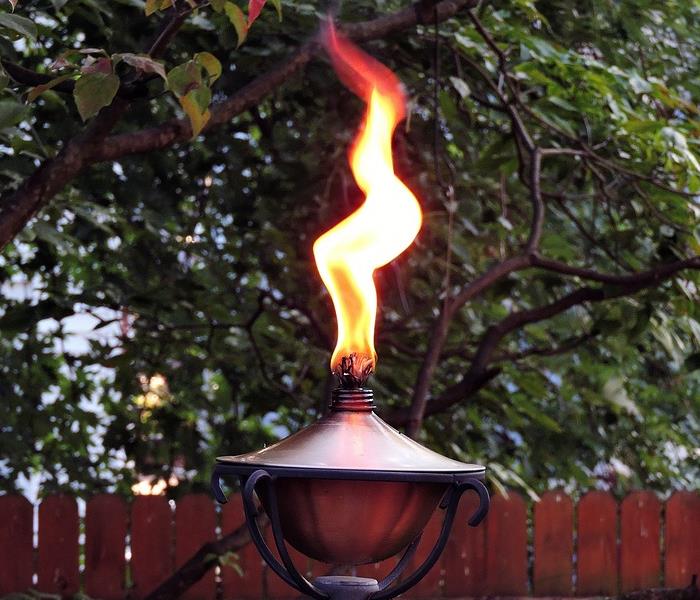 Open flame tiki torch in a backyard.
Open flame tiki torch in a backyard.
Summer outdoor parties are some of the best events of the year and one of the safest ways to enjoy summer in the midst of our ongoing pandemic.
The warm nights, food cooking on the grill, and friends and family spending quality time together in the backyard or around the pool create wonderful memories that last a lifetime. But, hosting outdoor events also means there’s an increased risk of home fires.
Fortunately, following some simple safety tips and guidelines can help ensure you and your guests stay safe. Consider the following as you host your next outdoor event:
- Have an adult present at all times when a portable fireplace is burning
- Use sturdy candle holders that won’t tip over easily
- Keep anything that can burn, as well as children and pets, at least three feet away from open flames
- Use battery-operated flameless candles and solar-powered patio (tiki) torches in place of an open flame. Flameless candles come in all colors, shapes, and sizes, and many are scented. Flameless candles look and feel like the real ones, and add a beautiful soft glow to any outdoor event.
Outdoor entertaining by the numbers
- Outside fireplaces or fire pits caused nearly 3,700 grass and brush fires
- Outdoor patio heater or fire pit injuries have grown each year
- More than half of all candle fires start when things that can burn are too close to the candle
- An average of over 8,800 home fires involved grilling activities each year
- Annually, sparklers, fountains, and novelties account for up to 25% of emergency room fireworks-related injuries.
Contact us at 908-650-8611 if you have a service need or click here to visit our website to learn more about SERVPRO of Hamilton, South Trenton System Services.
Learn More About Our “Restore First” Mentality
10/7/2021 (Permalink)
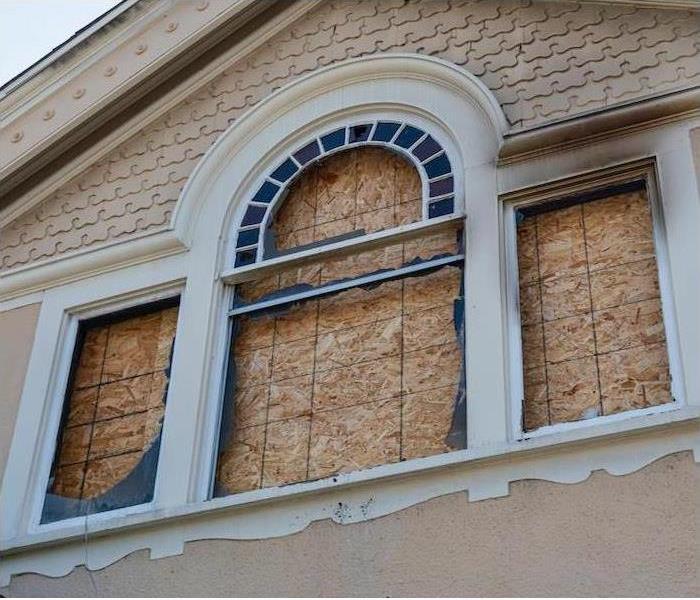 Our team of highly trained restoration experts are available for emergency cleanup and restoration services 24 hours a day, seven days a week.
Our team of highly trained restoration experts are available for emergency cleanup and restoration services 24 hours a day, seven days a week.
When disaster strikes, we get there fast, but that is not the only reason why we need to be first on your list of calls if the worst should occur.
What sets us apart—our team of technicians have a “restore first” mentality, complemented by specialized equipment and cleaning techniques. By making this our mission, we are able to minimize potential disruptions to your home and life and get you back into your home as quickly as feasible.
How It Works
When a fire has damaged your property, it’s a scary time, but once you reach out to our team, we’ll take some of the weight off your shoulders.
No two fires act the same, so it’s logical that the damage they inflict would also be different. That’s why we believe in starting with a standardized process, but adding onto it and enhancing it to meet your individual needs.
1. You call us. When you reach out via our 24⁄7 Emergency Line, we will spring into action. Our first step is to ask you questions about the fire and your home’s unique space and needs. That set of questions helps inform our strategy.
2. We inspect and assess the fire damage. Our next step is to visit your home. During this visit, we will inspect and test adjoining rooms of the property to determine the extent of fire, smoke and soot damage. Based on what we see and determine, we will take immediate next steps.
3. We board up windows and tarp the roof. Because fire damage often compromises windows, walls and roofs, we will make sure that your property is secured and protected from further damage. This will involve boarding up missing windows and walls and placing a tarp over the top of damaged roofs.
4. We remove water and begin the drying out process. When we think of fire, we don’t think of water damage. But we should, because water is a necessary component of fighting fires. So our next step is to remove any standing water and start drying out objects and spaces when possible.
5. We remove smoke and soot from all surfaces. We use specialized equipment and techniques to remove smoke and soot from ceilings, walls and other surfaces in your home.
6. We clean and sanitize your home. This is another place where the “restore first” mentality comes into play. We will attempt to clean objects and surfaces whenever possible, rather than removing and replacing them. We also use industrial air scrubbers and fogging equipment to help remove odors.
7. We complete the restoration. This is our final step, bringing your property back to the condition it was in before the fire. Restoration may involve minor repairs like replacing drywall, painting and installing new carpet. It could also involve major repairs like reconstruction of damaged areas.
Remember, if you need us, we’ll be there—no matter the time or day. Our team of highly trained restoration experts are available for emergency cleanup and restoration services 24 hours a day, seven days a week.
How to Protect Your Home from a Fire When Electricity Returns| SERVPRO® of Hamilton/South Trenton
8/18/2021 (Permalink)
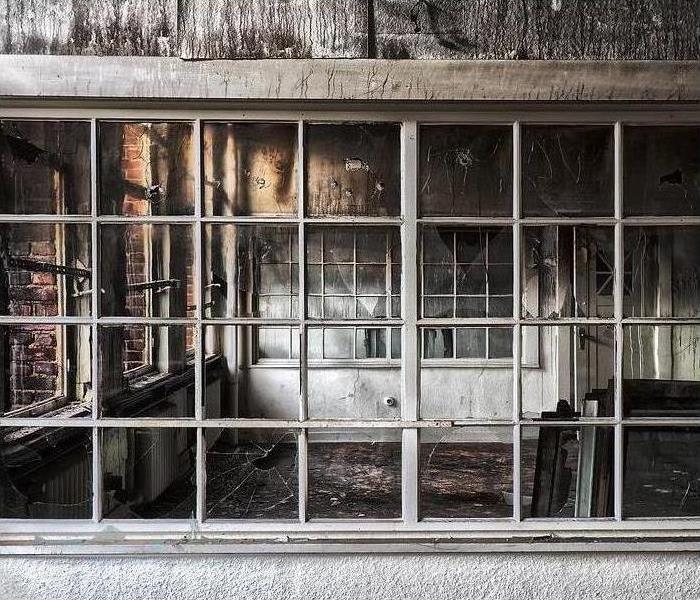 Having a team on your side after a disaster can help relieve stress. SERVPRO® of Hamilton, South Trenton is here to help 24/7.
Having a team on your side after a disaster can help relieve stress. SERVPRO® of Hamilton, South Trenton is here to help 24/7.
Did you know that when your power comes back on, the initial surge can cause damages to your appliances or possibly a fire if they are still plugged in.
In the United States, it is reported that a home fire is put on record every 24 seconds according the NFPA. That works out to be nearly 8,600 house fires a day.
Though the vast majority of house fires are cooking related, surges, malfunctioning appliances and frayed wires or cords are also often to blame. Because fire can spread rapidly and can quickly consume an entire house, it is essential to be vigilant in prevention for the safety of your household (even during a disaster).
Prevention Tips When The Power Goes Out
- Walk around an unplug bigger power users, television, computers, appliances, and turn off smaller ones like lamps and radios.
- Turn off the main supply of power to the house or remove the fuses.
- During summer months, turn the air conditioner off.
By following these tips, you can mitigate the risk of frying your electronics or overloading your house’s circuits.
When The Power Comes Back On
Once the power returns, wait a few minutes before turning on the main supply switch. To give the electrical system a chance to stabilize, turn on essential appliances first, then gradually turn on other electronics.
Restarting appliances all at once can almost double the amount of electricity that they use when running normally. When the main switches are re-energized, this demand can cause breakers to trip. It helps if you don't have all your appliances waiting to draw power the instant it is restored.
Fire and smoke damage can be devastating to your home, and in many circumstances, can be accompanied by water damage. If your home is damaged by fire or smoke, we are here to help restore your home to pre-fire condition. Contact us at (908) 650-8611.
We are available for cleanup and restoration services 24 hours a day, seven days a week.
How to Prevent House Fires | SERVPRO® of Hamilton, South Trenton
8/3/2021 (Permalink)
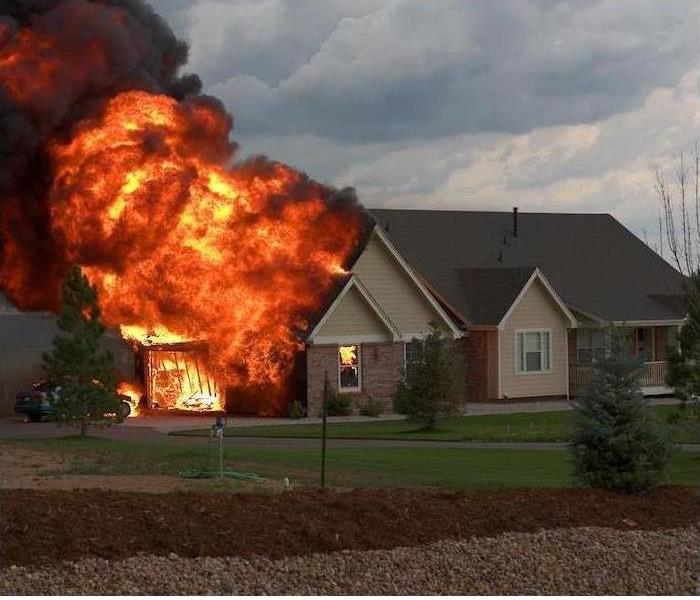 If your home has suffered damage from a house fire, give us a call. We are certified in fire and soot remediation, and here to help 24/7.
If your home has suffered damage from a house fire, give us a call. We are certified in fire and soot remediation, and here to help 24/7.
Smoke alarms are a great tool for house fire prevention, but they are not the only way to lessen your risk.
The causality of house fires is varied, but one thing that is consistent is how frequently they occur. By learning about the statistics and proven prevention methods, homeowners can keep their families safe.
The Numbers Behind House Fires
In the United States, it is reported that a home fire is put on record every 24 seconds according to the NFPA. That works out to nearly 8,600 house fires a day.
Though the vast majority of house fires are cooking-related, malfunctioning appliances, frayed wiring or cords, and carelessness with open flames are also often to blame. Because fires spread rapidly and can quickly consume an entire home, it is essential to be vigilant in prevention for the safety of your household.
House Fires Prevention Tips
Being proactive is the best defense against house fires. By keeping these fire prevention tips in mind, you can minimize your risk and keep your home safer:
Maintain smoke detectors. Maintain your smoke detectors by testing them each month and replacing them every 10 years.
Clean the dryer. After each load of laundry is dried, make a point to clear lint from the tray. Lint can build up and become a fire hazard when the dryer gets warm.
Keep an eye on open flames. Fires can start and spread faster than you think, which is why it is never wise to leave the room when there is an open flame. Whether it is a candle, cooking flame or fireplace, always keep an eye on them.
Maintain electrical cords. Cords and electrical wires should be checked often for frayed spots and immediately replaced if they are present. Never run electrical cords under rugs or behind furniture, as they can produce heat.
Read product labels. Chemicals in household products can be highly flammable, and so can products that come in aerosol cans. Keep these away from sunlight or heat sources.
Avoiding Fire Hazards While Cooking | SERVPRO® of Hamilton, South Trenton
8/3/2021 (Permalink)
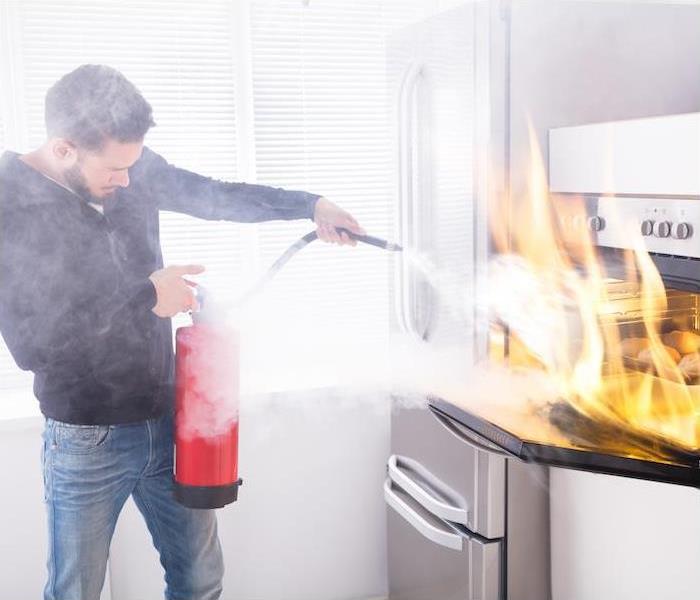 If your home has experienced damage from a cooking fire, know that we are here to make it “Like it never even happened."
If your home has experienced damage from a cooking fire, know that we are here to make it “Like it never even happened."
Even though the kitchen can be a wonderfully versatile place for family and friends to gather to enjoy a fresh-cooked meal or to spend quality time together, danger can lurk. Unfortunately, home fires can often begin in the kitchen.
Fires resulting from cooking are the No. 1 cause of home fires and injuries and, often, the leading cause of these kitchen fires is unattended cooking.
Over $130 million in homeowners insurance claims that were related to grease and other cooking fires were paid out in 2017 by State Farm Insurance. According to the insurance company, these are the worst states for kitchen fires:
- North Carolina
- Texas
- Pennsylvania
- California
- Ohio
- Illinois
- Maryland
- New York
- Alabama
- Georgia
Staying Safe in the Kitchen
There are other safety tips to look into, as well as the well-known tip of remaining in the kitchen while cooking. Here are some other helpful tips to observe while cooking:
1. Be careful of your clothing. If you are wearing long, flowing sleeves or loose fitting clothing, it is best to change into a short or close-fitting sleeved shirt or make sure any loose shirts are tucked in or tied back away from the stove. Loose clothing could catch fire if you aren’t careful and get too close while cooking over the stove.
2. Be aware of what you are placing on or near the stovetop. Make sure there are no kitchen towels, oven mitts, appliance cords or even curtains too close to the stovetop when cooking. Ideally, it is best to move anything flammable away from the stove.
3. Place a fire extinguisher in or close to the kitchen. It is best to have at least one fire extinguisher located in your home and, ideally, one that is near your kitchen. Make sure you know how to properly use the extinguisher, just in case it is ever needed.
4. Wait before throwing hot grease in the garbage can. Even if the grease may not be on fire, it could still be hot enough to cause something in the trash to burn. Letting the grease cool a bit and then disposing of it in an old coffee can is safest. Also, know the smoke points of the oils you cook with. Be sure to never subject a low-smoke point oil to high heat when cooking, as it could catch fire.
5. Be sure there is a fire escape plan established. Thinking about the worst that can happen is not fun, but it’s better if you are over-prepared rather than unprepared if an emergency were to occur. Go over exit routes and designated meeting points with your family, making sure that everyone knows what to do.
Fire safety in the kitchen is an absolute necessity, as it can help prevent dangerous and destructive cooking fires. If your home has experienced damage from a cooking fire, know that SERVPRO of Hamilton, South Trenton is here to make it “Like it never even happened.”
Fire Safety Basics to Help Protect your Family | SERVPRO® of Hamilton & South Trenton
7/9/2021 (Permalink)
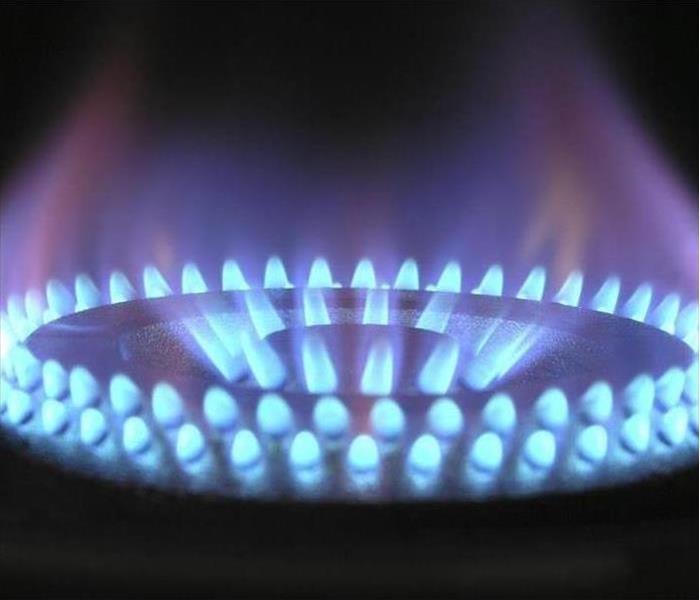 A quick response time with an alert team will assure that your restoration needs are professionally completed.
A quick response time with an alert team will assure that your restoration needs are professionally completed.
Every year in the United States, more than 350,000 house fires happen, adding up to more than $5.5 billion in property damage. Beyond the financial loss, these fires also lead to nearly 3,000 deaths and another 10,000 injuries.
The best defense for your family against a fire is to prepare in advance. That’s why it’s important for every person to know how to prevent fires and how to respond if one occurs.
Start teaching your kids basic fire safety guidelines when they’re young. Let’s also take a look at three other fire safety practices you can practice as a family:
Watch Out for Fire Hazards
Go through your home. You might be surprised how many fire hazards you spot! Take some time and go through every room and your outdoor space to uncover any hazards.
- Ensure your appliances are in good shape.
- Check that electrical cords are in workable condition.
- Do not overload outlets and/or extension cords.
- Check to make sure you are using the correct wattage of lightbulbs.
- Double-check that electrical wiring is not covered up by rugs or carpet.
Creating Your Fire Plan
In the event of a fire, every person in the family needs to know what to do—including how to get out of the house and where to go once they’re out.
But don’t just create a plan and not have practice drills. After all, as the saying goes, “practice makes perfect.” Regular practice of what to do makes you more likely to remember the steps if an actual fire occurs.
Practice Kitchen Fire Safety
Cooking is the biggest single cause of home fires. That’s why it’s important to be especially careful in the kitchen.
Anyone who’s cooking needs to familiarize themselves with basic cooking safety:
- Never cook when tired or unable to pay attention.
- Do not leave kids and teens alone when they cook.
- Always keep a lid at hand when cooking on the stove in case of a grease fire. If a small grease fire occurs, use the lid to smother the fire.
- If a fire occurs in the oven, turn it off and keep the door closed.
- Leave the room and close the door if a kitchen fire occurs and begins to spread.
If your family has experienced a fire and needs help restoring your home, SERVPRO® of Hamilton & South Trenton can help! Give us call to learn about our fire restoration services and what we can do for you.
Can You Identify Common Fire Hazards in Your Home? | SERVPRO of Hamilton/South Trenton
6/4/2021 (Permalink)
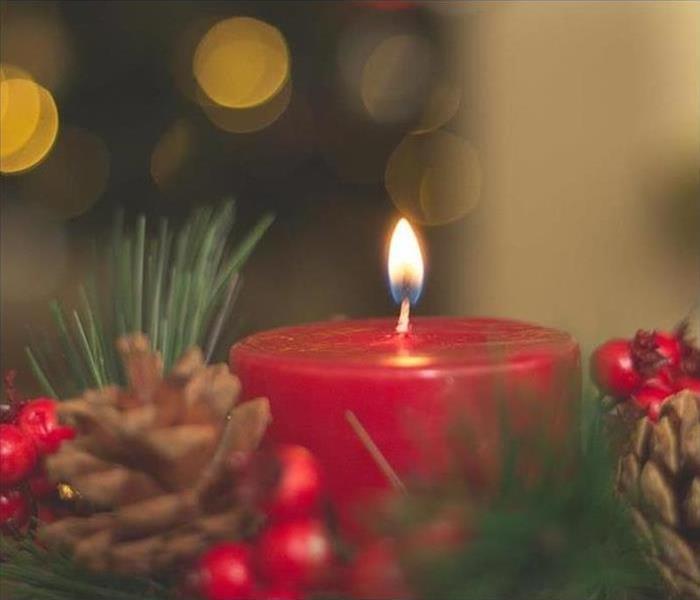 If your home is damaged by fire or smoke, we are here to help restore your home to pre-fire condition.
If your home is damaged by fire or smoke, we are here to help restore your home to pre-fire condition.
Nobody wants to think about the possibility of their home being damaged by fire, but it’s an unfortunate, harsh reality for a multitude of Americans.
One way you can help protect your home is to understand fire hazards and know how to identify them. In this blog, let’s dive into two of the most common causes of household fires.
Candles are a common fire hazard.
According to the National Fire Protection Association, over a five-year period from 2011 to 2015, fire departments across the United States answered an estimated 8,700 house fires a year that were caused by candles.
In total, these fires caused 82 deaths, 800 injuries and $295 million in property damage. Candles were the cause of 2 percent of reported house fires, of which 3 percent resulted in death and 7 percent resulted in injuries.
An average of 24 home candle fires per day were reported during those five years, with December having the highest month of incidents. Out of all the candle fires during this time period, 37 percent started in the bedroom and were responsible for 36 percent of the associated deaths and 51 percent were associated with injuries.
When using a candle, be sure it’s kept at least one foot away from anything that could possibly ignite and that it is in a sturdy holder that will not easily tip over. It is never wise to use a candle where oxygen is in use in a home. And you always want to ensure that all candles are properly extinguished before leaving a room or going to sleep.
House fires from smoking can be lethal.
While cooking is the leading cause of house fires, smoking is the main cause of home fire deaths. Approximately 17,200 house fires were reported in 2014 due to smoking, which includes cigarettes, pipes and cigars. Those fires resulted in 570 deaths, 1,140 injuries and $426 million in property damage, according to the Coalition for Fire-Safe Cigarettes.
If you’re a smoker, it is smart to smoke outside, as most deaths result from fires that started in living rooms, family rooms or bedrooms. Fire-safe cigarettes are the best option, and using a deep, sturdy ashtray is advised.
Drop all lit cigarettes and ashes in water or sand prior to throwing them out—and remember that one out of four fatal victims of smoking fires is not the smoker whose cigarette started the fire.
Dust bunnies as fire hazards?
While candles and smoking are well-known causes of home structure fires, were you aware that some glassware in your home could be a fire risk? When sunlight passes through them, the concentrated ray may ignite flammable materials. It’s best to keep glass accessories away from windows and out of direct sunlight.
Dust bunnies can also pose a fire risk when they collect near electrical sockets and floor heaters. Regular sweeping or vacuuming regularly and cleaning hard-to-reach areas like behind entertainment systems can help prevent buildup.
Also, look for loose outlets in your home. The movement of these outlets loosens the wires connected to the outlet and could create dangerous arcing.






 24/7 Emergency Service
24/7 Emergency Service
















